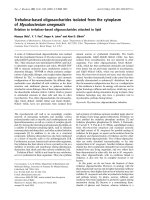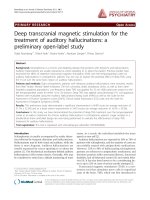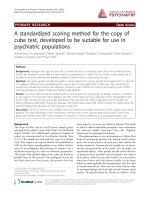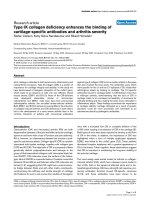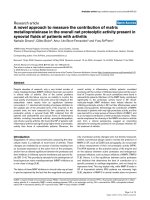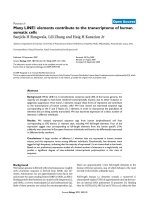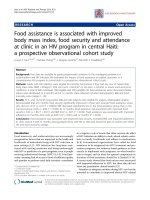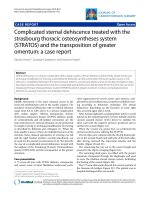Báo cáo y học: "Complicated sternal dehiscence treated with the strasbourg thoracic osteosyntheses system (STRATOS) and the transposition of greater omentum: a case report" pot
Bạn đang xem bản rút gọn của tài liệu. Xem và tải ngay bản đầy đủ của tài liệu tại đây (719.21 KB, 3 trang )
Ceresa et al. Journal of Cardiothoracic Surgery 2010, 5:53
/>Open Access
CASE REPORT
© 2010 Ceresa et al; licensee BioMed Central Ltd. This is an Open Access article distributed under the terms of the Creative Commons
Attribution License ( which permits unrestricted use, distribution, and reproduction in
any medium, provided the original work is properly cited.
Case report
Complicated sternal dehiscence treated with the
strasbourg thoracic osteosyntheses system
(STRATOS) and the transposition of greater
omentum: a case report
Fabrizio Ceresa*
1
, Giuseppe Casablanca
2
and Francesco Patanè
1
Abstract
Sternal dehiscence is a serious complication after cardiac surgery. Sternal refixation, performed by simple rewiring or
techniqual modification of rewiring as described by Robicsek, can fail, overall when the bone quality is poor or the
sternum is completely destroyed. The sternal closure systems, consisting of plates, screws or rib clips and titanium bars,
have been recently introduced to treat the complicated sternal dehiscence. We describe for the first time the use of the
Strasbourg Thoracic Osteosyntheses System (STRATOS) and the greater omentum, to treat a complicated sternal
dehiscence, causing chest pain and respiratory failure.
Background
Middle sternotomy is the most common access to the
heart and mediastinum used in the cardiac surgery. The
incidence of sternal dehiscence with or without infection
range from 0,5 to 5,0% and it is a serious complication
after cardiac surgery. Obesity, osteoporosis, chronic
obstructive pulmonary disease (COPD), diabetes, intake
of corticosteroids and off-midline sternotomy are the
main risk factors [1]. Sternal refixation can be performed
by simple rewiring or techniqual modification of rewiring
as described by Robicsek and colleagues [1]. When the
bone quality is poor or there are multiple fractures of the
sternum, these classical approaches of rewiring can fail
and the rigid fixation systems, recently introduced, can
be used for the sternal reconstruction [1,2]. We describe
the case of a complicated sternal dehiscence, treated with
the implant of the Strasbourg Thoracic Osteosyntheses
System (STRATOS) and the transposition of the greater
omentum.
Case presentation
A 75 years-old man with COPD, diabetes, osteoporosis
and recent onset of atrial fibrillation underwent aortic
valve replacement for severe aortic valve stenosis, com-
plicated by sternal dehiscence, treated by modified rewir-
ing according to Robicsek's technique. The sternal
dehiscence, depending on the fractures of some right
ribs, occurred again after a week.
After having implanted a polypropylene patch to avoid
injuries to the underlying heart, we have initially used the
vacuum assisted closure (VAC) device to stabilize the
chest wall with the negative pressure produced and to
sterilize the wound (Figure 1A).
When the wound was germe-free, we performed the
sternal reconstruction, utilizing the STATOS.
The rib clips were crimped with the rib clip fixation pli-
ers on the second, fourth and sixth ribs of the both sides,
after having removed the intercostal muscles and the
bundle. (Figure 1B and 1C).
The connecting bar was cut to the correct length and
secured to the clip by crimping (Figure 2A).
The remaining dead space was filled with the greater
omentum, transposed through the diaphragm and used
to cover the titanium sternal closure system, facilitating
the healing of the wound (Figure 2B)
The CT scan afterwards showed the correct position of
the titanium rib bridges (Figure 2C). The patient was in
hospital discharged after one month.
* Correspondence:
1
Cardiac Surgery Division, Papardo Hospital, Messina, Italy
Full list of author information is available at the end of the article
Ceresa et al. Journal of Cardiothoracic Surgery 2010, 5:53
/>Page 2 of 3
Discussion
Sternal dehiscence with or without infection is a serious
complication after sternotomy and it increases the mor-
tality and morbidity rates [1].
When the bone is very osteopenic, the classical tech-
niques of rewiring are associated with a high rate of
recurrence dehiscence. New approaches of sternal recon-
struction, based on the use of orthopaedic, plastic and
maxillofacial fixation systems, have been recently intro-
duced. The sternal closure systems, consisting of tita-
nium reconstruction plates, cables and screws, perform a
transverse rib-to-rib stabilization without the adhesioly-
sis of the substernal area, extending the zone of fixation
beyond the fractured sternum to the ribs laterally, where
the bone quality should be better [1,2].
We have carefully assessed what was the better sternal
refixation system to use in our case.
The STATOS has been recently utilized to treat surgi-
cally the chest wall deformities as Pectum excavatum, to
stabilize the fractures after severe thoracic trauma or to
reconstruct the chest wall after removal of a tumoral
mass [3].
Each implant consists of two rib clips straight united by
a connecting bar. The three different angulations of the
rib clips and the adjustable length of connecting bar allow
to use this system for any anatomical situations.
The rib clip is clung to the rib through "small handles",
that surround it without compressing the vasculo-ner-
vous bundle. In this way the rib should be weakened less
than by the bi-cortical insertion of the screws.
The remaining dead space after sternal reconstruction
has been filled with the greater omentum. The use of the
greater omentum in the treatment of the mediastinitis
and deep sternal wound infection has been described in
the literature and its immunological and angiogenetic
properties can prevent the further extension of local
infection and facilitate the primary closure of the superfi-
cial tissues, leading to the healing of the sternal wound
[4].
In conclusion, we purpose the use of STRATOS, cov-
ered by the transposition of the greater omentum, to treat
the complicated sternal dehiscence after sternotomy, par-
ticularly in those cases in which the bone quality is poor
and the sternum is completely destroyed. This system is
effectiveness in the stabilization of the chest wall, reduc-
ing the pain, improving the ventilation and facilitating the
quick healing of the wound.
Authors Contributions
Ceresa Fabrizio and Patane Francesco had written the
case report. Casablanca Giuseppe had dealt the images.
All authors read and approved the final manuscript.
Consent
Written informed consent was obtained from the patient
of this case report and accompanying the images. A copy
of written consent is available for the review by the Editor
in Chief of this journal
Competing interests
The authors warrant that no ethical problem or conflicts of interest regarding
this paper exist.
Author Details
1
Cardiac Surgery Division, Papardo Hospital, Messina, Italy and
2
Thoracic
Surgery Division., Papardo Hospital, Messina, Italy
Figure 1 The sternal wound is opened and the right half of the sternum is completely destroyed (A). The intercostal muscles and the bundle
is removed (B). The rib clips are clung to the rib through "small handles" that are crimped with the rib clip fixation pliers (C).
Figure 2 The connecting bars are secured to the rib clips, posi-
tioned on the second, fourth and sixth ribs (A). The greater omen-
tum has been used to cover the STRATOS fixation system (B). Three-
dimensional computed tomography reconstruction showing the tita-
nium rib bridges maintaining the chest stability (C).
Ceresa et al. Journal of Cardiothoracic Surgery 2010, 5:53
/>Page 3 of 3
References
1. Voss B, Bauernschmitt R, Albrecht W, Krane M, Kröss R, Brockmann G,
Libera P, Lange R: Sternal reconstruction with titanium plates in
complicated sternal dehiscence. Eur J Cardiothorac Surg 2008,
34:139-145.
2. Huh J, Bakaeen F, Chu D, and Wall MJ: Transverse sternal plating in
secondary sternal reconstruction. J Thorac Cardiovasc Surg 2008,
136:1476-1480.
3. Coonar AS, Qureshi N, Smith I, Wells FC, Reisberg E, Wihlm JM: A novel
titanium rib bridge system for chest wall reconstruction. Ann Thorac
Surg 2009, 87:e46-e48.
4. Moreschi AH, Vieria de Maredo Neto A, Barbosa GV, Saueressig MG:
Aggressive treatment using muscle flap or omentopexy in infections of
the sternum and the anterior mediastinum following sternotomy. J
Bras Pneumol 2008, 34(9):654-660.
doi: 10.1186/1749-8090-5-53
Cite this article as: Ceresa et al., Complicated sternal dehiscence treated
with the strasbourg thoracic osteosyntheses system (STRATOS) and the
transposition of greater omentum: a case report Journal of Cardiothoracic Sur-
gery 2010, 5:53
Received: 21 October 2009 Accepted: 28 June 2010
Published: 28 June 2010
This article is available fro m: http://www. cardiothoracics urgery.org/con tent/5/1/53© 2010 Ceresa et al; licensee BioMed Ce ntral Ltd. This is an Open Access article distributed under the terms of the Creative Commons Attribution License ( ), which permits unrestricted use, distribution, and reproduction in any medium, provided the original work is properly cited.Journal of Cardiothoracic Surgery 2010, 5:53
